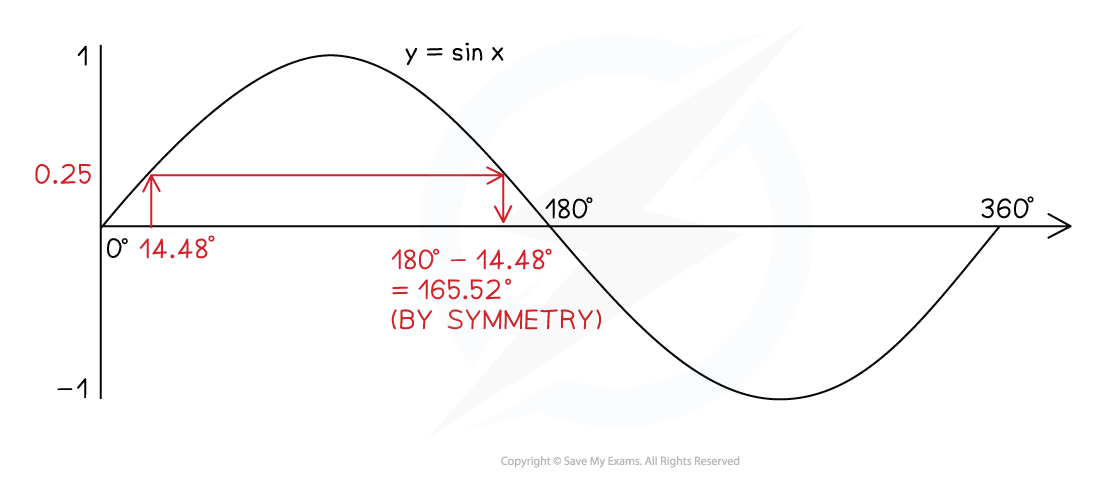Solving Trig Equations (Cambridge (CIE) IGCSE Maths) : Revision Note
Solving Trig Equations
What are trig equations?
Trig equations are equations involving
,
and
They often have multiple solutions
A calculator gives the first solution
You need to use trig graphs to find the others
The solutions must lie in the interval (range) of
given in the question, e.g.
How do I solve sin x = ...?
Find the first solution of the equation by taking the inverse sin function on your calculator (or using an exact trig value)
E.g. For the first solution of the equation
for
This gives
Then sketch the sine graph for the given interval
Identify the first solution on the graph
Use the symmetry of the graph to find additional solutions
E.g. For the equation
for
Sketch the graph
for
Draw on
By the symmetry, the new value of
is
The solutions are
or

Check the solutions
E.g. For the equation
for
Substitute
and
in to the calculator
and
both give a value of
, so are correct
In general, if
is an acute solution to
Then
is an obtuse solution to the same equation
How do I solve cos x = ...?
Find the first solution of the equation by taking the inverse cos function (or using an exact trig value)
E.g. For the first solution of the equation
for
This gives
Then sketch the cosine graph for the given interval
Identify the first solution on the graph
Use the symmetry of the graph to find additional solutions
E.g. For the equation
for
Sketch the graph
for
By the symmetry, the new value of
is
The solutions are
or

Check the solutions
E.g. For the equation
for
Substitute
and
in to the calculator
and
both give a value of
so are correct
In general, if
is a solution to
Then
is another solution to the same equation
How do I solve tan x = ...?
Find the first solution of the equation by taking the inverse tan function (or using an exact trig value)
E.g. For the first solution of the equation
for
This gives
Then sketch the tangent graph for the given interval
Identify the first solution on the graph
Use the periodic nature of the graph to find additional solutions
E.g. For the equation
for
Sketch the graph
for
By the periodic nature, the new value of
is

Check the solutions
E.g. For the equation
for
Substitute
and
in to the calculator
and
both give a value of
so are correct
In general, if
is a solution to
Then
is another solution to the same equation
How do I rearrange trig equations?
Trig equations may be given in a different form
Equations may require rearranging first
E.g.
can be rearranged to
They can then be solved as usual
What do I do if the first solution from my calculator is negative?
Sometimes the first solution given by the calculator for
will be negative
Continue sketching the graph to the left of the
-axis to help
Then find solutions that lie in the interval given in the question
Examiner Tips and Tricks
Know how to use the inverse functions on your calculator
It may involve exact trig values which do not need a calculator
Check your solutions by substituting them back into the original equation
Worked Example
Use the graph of to solve the equation
for
.
Give your answers correct to 1 decimal place.
Use a calculator to find the first solution
Take the inverse sin of both sides
Sketch the graph of
Mark on (roughly) where and
would be
Draw a vertical line up to the curve
Draw another line horizontally across to the next point on the curve
Bring a line vertically back down to the x-axis

Find this value using the symmetry of the curve
Subtract 14.48 from 180
Give both answers correct to 1 decimal place
or

You've read 0 of your 5 free revision notes this week
Sign up now. It’s free!
Did this page help you?

